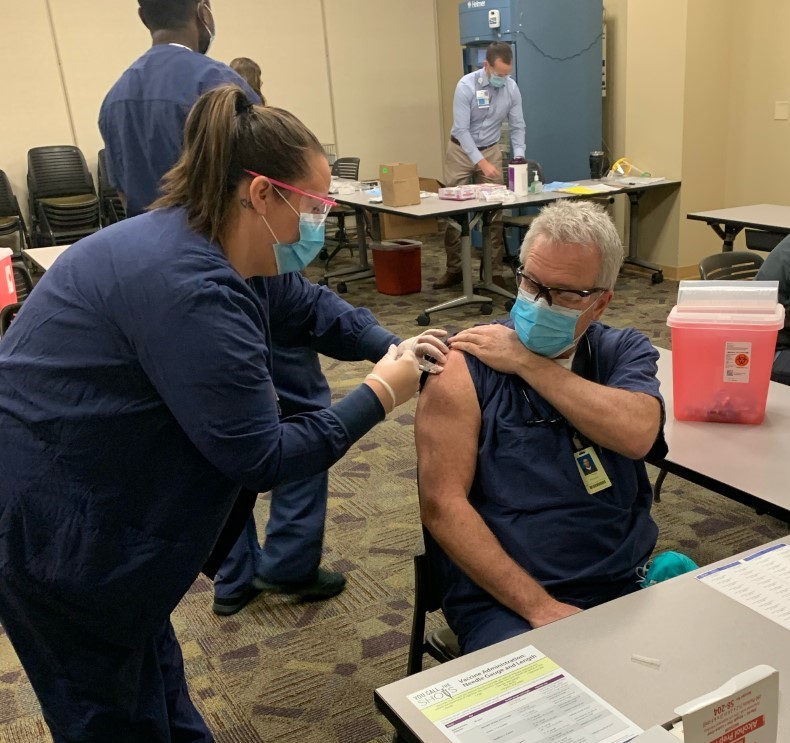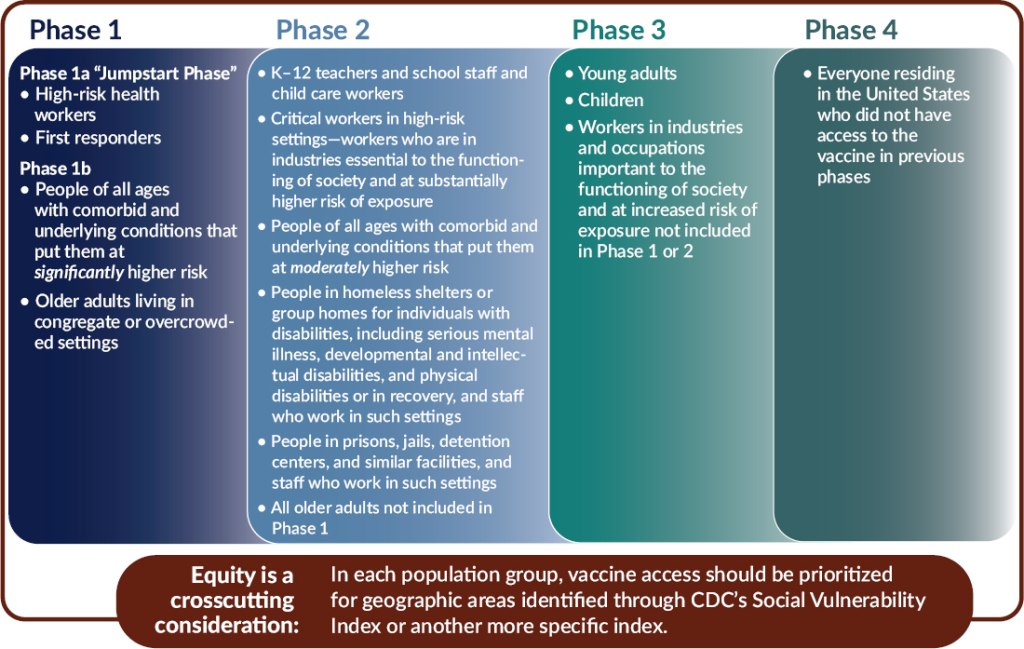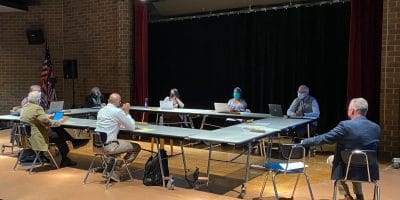
By Calvin Pynn, contributor
After the Monday night arrival of a first shipment of Pfizer’s COVID vaccine at Sentara RMH, Mark Nesbit, an emergency medicine doctor, volunteered to get his shot right away. He didn’t realize until he arrived at the hospital’s employee health clinic on Thursday morning, however, that he would be the very first person at the hospital to receive it.
“I didn’t really have to do anything special, I just signed up,” Nesbit said.
Nesbit was one of several frontline healthcare workers at the hospital who were vaccinated early Thursday morning. After a 15-minute monitoring period – standard hospital protocol – he was off to a 7a.m. shift in the Emergency Department.
“There were no problems at all. It’s very similar to getting the flu vaccine. They just clean off your shoulder and inject it with a very small needle and just happened to hit a spot where I couldn’t even feel it,” Nesbit said.
Receiving the long-awaited vaccine came with a side dose of optimism.
“I feel good, you know. I feel like this is the start of a next phase of management of this disease, and hopefully as more high risk people get it, we can hopefully see things start to drop off and people can start to have some normalcy in their lives,” Nesbit said.
As an emergency medicine doctor, Nesbit is among the hospital’s high-risk providers, along with those who work in close proximity with COVID patients in intensive care. Other providers, such as OB-GYNs, ENTs, and anesthesiologists fall into that category as well, and, along with first responders, comprise the first subcategory of the Center for Disease Control’s Phase 1 for vaccine distribution.

The next subcategory of Phase One recipients includes residents and staff at long term care facilities. At Virginia Mennonite Retirement Community, details about vaccine clinics will be communicated in the coming week, said Maureen Pearson, vice-president of marketing.
Phase 2 includes teachers and other public school employees, inmates and staff at correctional facilities, some essential workers and people who are immunocompromised. Children and other essential workers will be vaccinated in Phase 3, while everyone else falls into Phase 4 – a group expected to have access to vaccines in the spring.
According to its website, the Virginia Department of Health is currently enrolling providers – including hospitals, health departments, and urgent care centers – to administer the vaccine as it becomes more widely available. The vaccine will be provided free of charge, regardless of insurance or income status. Both the Pfizer vaccine and another by Moderna – in the final stages of approval – are expected to be available. Both require two doses; Pfizer’s second dose has to be administered three weeks from the first, while Moderna’s second dose has to be administered four weeks later.
In a press teleconference hosted by Sentara Medical Group earlier this week, it was announced that hospitals across Virginia are expecting to receive 20,800 doses of the Moderna vaccine by December 21.
According to Sentara’s Chief Pharmacy Officer Tim Jennings, more of Sentara’s direct-care workers will have access to the vaccine once the Moderna shipment arrives.
“I’m pretty sure we will be very close if not able to cover a majority of our healthcare workers. It may take one more partial shipment to get us through, but eventually we will have enough doses to get our employees, and then beyond,” Jennings said.
The vaccine will not be mandated by the VDH, nor will it be required for Sentara’s employees. According to Nurse Executive Mary Morin, a survey sent out to all employees in Sentara’s network showed that 80 to 85 percent want to take the vaccine – and she believes that number will grow.
“I think we will see as people start to get the vaccine and its efficacy as it’s broadly shared, we will begin to see a higher vaccine rate amongst our healthcare workers,” Morin said.
Sentara spokesperson Dale Gaulding told The Citizen he was unsure of how many RMH employees did not indicate interest in the vaccine in the Sentara survey. According to Jennings, though, a small group opting out will not pose a risk to public health.
“Herd immunity usually occurs when you’re over 60 to 70 percent. So if we get a good 80 plus percent of our healthcare employees, then we’re contributing very well to the overall immunization, and I have a feeling that might creep a little higher simply because of interest,” he said.
Nevertheless, other protocols will still be followed, according to Morin.
“Our staff will still be wearing personal protective equipment when caring for patients, whether they’ve gotten the vaccine or not,” Morin said.
Nesbit, the first local vaccine recipient, also emphasized the importance of maintaining current protocols even as vaccines arrive in the community.
“I think it’s really important going into the holidays. People are cognizant of how important it is to stay isolated, even during a time when we’re used to congregating, but I think it’s especially important to remember that with this vaccine, we probably won’t see any benefit until a couple of weeks after the second vaccine,” he said.
“The shift I did today was in an area where we tend to take care of sicker people, and I probably saw five today that had to be hospitalized, so we’re definitely having a surge now,” Nesbit added.
Journalism is changing, and that’s why The Citizen is here. We’re independent. We’re local. We pay our contributors, and the money you give goes directly to the reporting. No overhead. No printing costs. Just facts, stories and context. We’re also a proud member of the Virginia Press Association. Thanks for your support.













